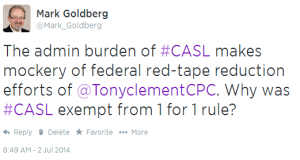Roadblocks for an innovation economy
An article yesterday in the Washington Post by Larry Downes says that the net neutrality debate has missed the point.
How did we get here? Despite the doomsday scares of a technology apocalypse, the current fight over who and how to regulate the Internet is not about the future of innovation, Internet access, broadband pricing, competition, fairness, or motherhood. It’s something much less exciting, though, depending on the outcome, much more dangerous.
Downes’ conclusion, “At best, a full or partial government takeover of Internet access would almost certainly slow future network evolution” sounds similar to what I wrote in 2008 in a post called “Can net neutrality limit innovation?”
Canada led the world in introducing enforceable net neutrality regulations when the CRTC introduced ITMP protocols for the implementation of internet traffic management in 2009.
Eight months earlier, in February 2009, in its Digital Britain strategy document, the UK said there was no need for net neutrality legislation. The UK was concerned that net neutrality regulation might prevent pricing innovation, differentiation of offers and serve to discourage investment in higher-speed access networks.
In its review of Mobile TV services, we see the CRTC’s regulatory forum being used to discourage precisely the kinds of pricing innovations that concerned the UK authorities. Downes wrote in his article in the Washington Post, “Just as taxicab companies are using regulators to stop Uber and Lyft, and hotels are lobbying for prohibitions on Airbnb, Netflix is using the net neutrality debate to improve its own bottom line.”
My views on Canada’s anti-spam law (CASL) are well known. I don’t think that it is a source of pride for Canada to have the democratic world’s toughest anti-spam regime. See, for example: “CASL is indefensible” and “CASL costs consumers“. As early as 2008, I warned “Worst case will see us get it wrong and introduce costs on legitimate businesses while doing nothing to stem the flow of the real garbage filling our inboxes.” In 2010, I wrote, “the bill would be better titled the Electronic Commerce Restrictions Act: it discourages many efficiencies that should be available to businesses of all sizes in reaching out to new customers.” CASL is yet another inhibitor for Canadian businesses to adopt digital technologies, and as I wrote earlier this summer, we should be wondering if CASL will limit the development of new technologies.
The CRTC’s own focus groups found that Canadians thought the Commission was “playing catch-up most of the time. The industry it regulates is changing so fast that the Commission never seems to be ahead of the change and is more reactive than proactive.”
This impression is a reality of attempting to regulate in the light-speed of our evolving digital economy.
Earlier this summer, Khosla Ventures had a “fireside chat” with Google co-founders Larry Page and Sergey Brin. They were asked “Can you imagine Google becoming a health company?” Brin replied:
Generally, health is just so heavily regulated. It’s just a painful business to be in. It’s just not necessarily how I want to spend my time. Even though we do have some health projects, and we’ll be doing that to a certain extent. But I think the regulatory burden in the U.S. is so high that think it would dissuade a lot of entrepreneurs.
The zeal with which regulators and legislators have intervened in Canada’s digital economy should be a concern to all of us. Is regulation protecting competition or competitors? Is regulation safeguarding consumers or building roadblocks for innovation?
In 2006, a Directive was sent to the CRTC [Order Issuing a Direction to the CRTC on Implementing the Canadian Telecommunications Policy Objectives]. At that time, Canada’s cabinet called for the CRTC to “rely on market forces to the maximum extent feasible as the means of achieving the telecommunications policy objectives, and when relying on regulation, use measures that are efficient and proportionate to their purpose and that interfere with the operation of competitive market forces to the minimum extent necessary to meet the policy objectives.”
Are we seeing regulatory measures from the CRTC and Industry Canada that are as “minimally intrusive and as minimally onerous as possible?”
As I wrote last year (echoing calls from two years earlier), we are long, long, long overdue for a fresh look at Canada’s telecom policy.






